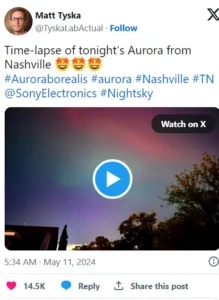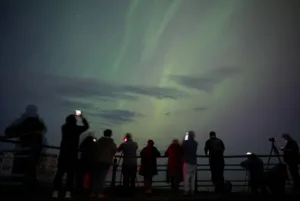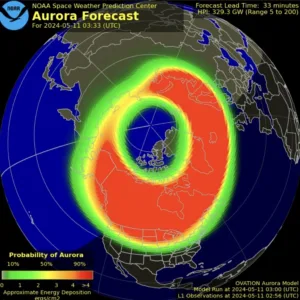Enthusiastic observers from various corners of the US and Europe flooded social media with stunning images of the Northern Lights, which illuminated the night sky with vivid shades of pink, purple, and green.
But what exactly are the Northern Lights?
This mesmerizing phenomenon presents itself as vibrant, swirling curtains of light gracefully dancing across the night sky, showcasing a breathtaking spectrum of colors ranging from emerald green to rosy pink and fiery scarlet.

The Northern Lights are formed through the interaction of charged particles from the Sun with gases in the Earth’s atmosphere. As these charged particles collide with atmospheric gases, they excite atoms and molecules, prompting them to emit light.
The distinctive colors of the aurora are attributed to the various gases in the Earth’s atmosphere being stimulated by the incoming charged particles. Oxygen atoms predominantly emit green light, the most common color observed in the Northern Lights, while nitrogen atoms emit hues of purple, blue, and pink.

The most spectacular displays of auroras occur when the Sun releases large clouds of particles, known as coronal mass ejections (CMEs), intensifying the interaction between solar particles and Earth’s magnetic field, thus amplifying the brilliance and extent of the auroral displays.
Incredible displays graced Friday night, following a rare solar storm warning issued by the US National Oceanic and Atmospheric Administration (NOAA), alerting people to the heightened likelihood of witnessing the Northern Lights.
While storms of this magnitude pose potential risks to infrastructure such as satellites and power grids, they also provide an unparalleled opportunity for skygazers to marvel at the beauty of the aurora borealis.

The Northern Lights were visible as far south as Alabama and northern California in the US, while several European countries, including Austria, Germany, Slovakia, Switzerland, Denmark, and Poland, were treated to the awe-inspiring spectacle.
Social media platforms buzzed with captivating images captured by eager skywatchers keen on sharing the magic of the moment. The Met Office and BBC Weather forecasted clear skies, offering optimal viewing conditions for enthusiasts across the UK.
The Northern Lights are expected to make a return on Saturday night, with meteorologists predicting favorable conditions for sightings extending into the weekend.
For those in the southern US unable to witness the aurora with the naked eye, experts suggested using smartphones to capture the phenomenon, as modern cellphone cameras excel at capturing low-light scenes.
Despite the potential challenges posed by solar storms, they present a captivating opportunity to witness the awe-inspiring beauty of the Northern Lights, a natural wonder that never fails to captivate and inspire.
So, if you missed your chance to witness the northern lights last night (like many of us did), don’t forget to look up tonight!




